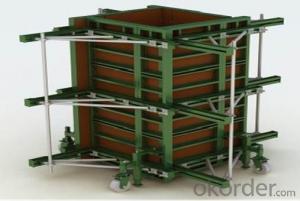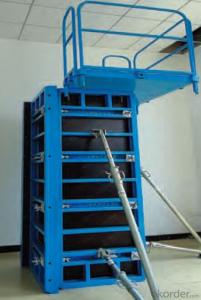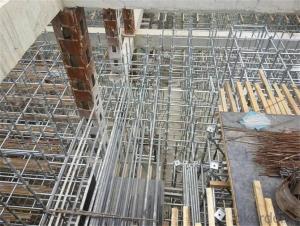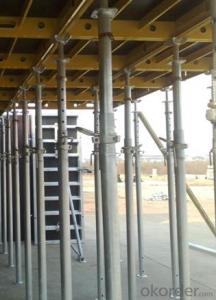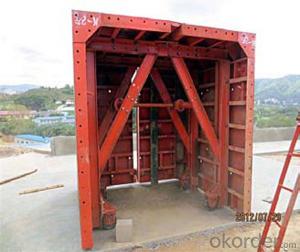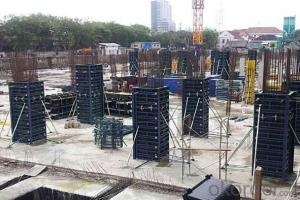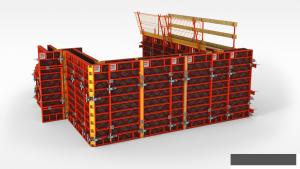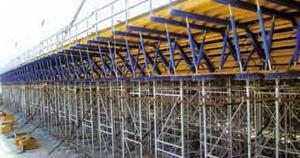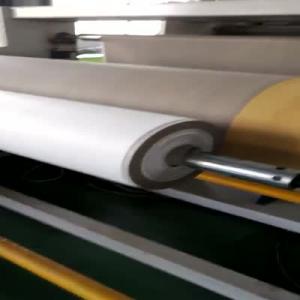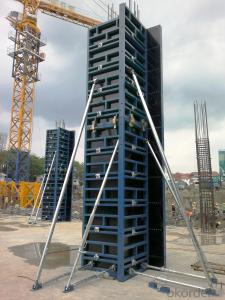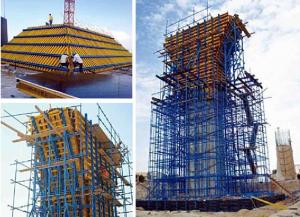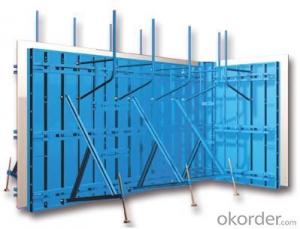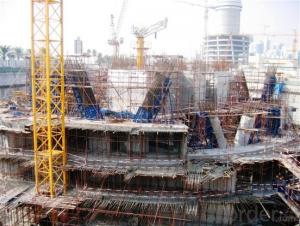CMAX 120 STEEL FRAMED FORMWORK FOR LIFTS SHAFT
- Loading Port:
- Shanghai
- Payment Terms:
- TT or LC
- Min Order Qty:
- 1000 m²
- Supply Capability:
- 100000 m²/month
OKorder Service Pledge
OKorder Financial Service
You Might Also Like
1. Structure of 120 Steel Framed Formwork Description
120 steel framed formwork is a new type formwork and is widely used for concrete pouring of single-side wall. The construction fast and easy very much. The components have good standard performance and versatility. The pouring height is adjustable, the maximum height of a single pouring is 8.9m.The formwork is always used different projects like basement, stair and other building. It is water proof.
2. Main Features of 120 Steel Framed Formwork
- assembly easily
-structure is simple
- transportation is convenient
3. 120 Steel Framed Formwork Images
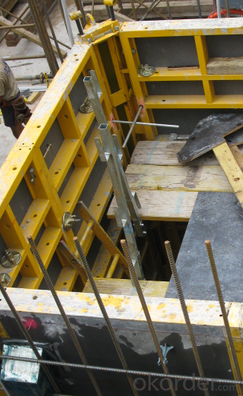
4. Single-side Steel Framed Formwork Specifications
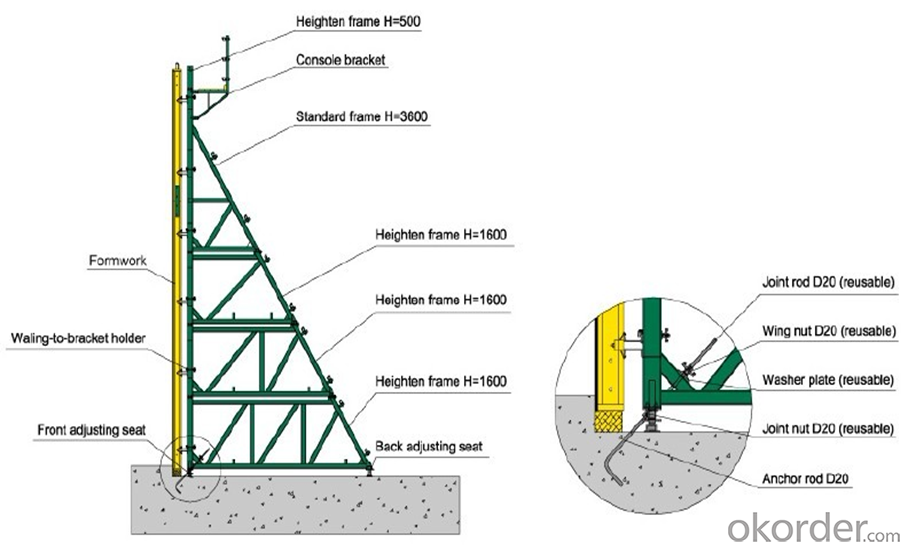
5.FAQ of 120 Steel Framed Formwork
1) What can we do for you?
.We can ensure the quality of the 120 steel framed formwork and avoid extra expenses for customers.
.We can provide you the professional technical team.
.We can provide professional building proposal for your project.
. Please feel free to customize.
2) What about of our after-sale service?
. Response will be carried out in 24hours after receiving any complain or request.
. Single side steel framed formwork cost can be refund after order is confirmed.
. If the products are not based on the requirements, there will be the relevant compensations made for you.
3) What about the package and shipping time?
.Packing: wood package and
.Shipping: by sea
Shipping time: Normally small orders, it just1week business days to arrive your hand; When comes to the customs declaration, it may need 2 weeks.
- Q:How does steel frame formwork affect the overall cost of concrete construction?
- The overall cost of concrete construction can be significantly affected by steel frame formwork. Despite seeming more expensive at first glance compared to timber or aluminum formwork, steel frame formwork offers numerous cost-saving advantages in the long run. To begin with, steel frame formwork is extremely durable and can endure multiple uses without experiencing significant wear and tear. This durability ensures that the formwork can be reused numerous times, reducing the need for frequent replacements and lowering material costs overall. Moreover, the strength and rigidity of steel frame formwork enable faster construction times. This efficiency can lead to reduced labor costs as fewer workers are required to complete the project within a shorter timeframe. The ability to pour concrete at a faster rate also decreases on-site labor expenses by minimizing the time spent waiting for the concrete to set. Additionally, steel frame formwork delivers precise and accurate results, resulting in minimal waste and therefore reduced material costs. The formwork's snug fit and smooth finish eliminate the necessity for excessive concrete patching or rework, saving both time and money. Furthermore, steel frame formwork is versatile and adaptable, making it suitable for various construction projects. Its modular design allows for customization and easy assembly, reducing the need for specialized equipment or additional construction materials. Lastly, steel frame formwork offers improved safety features, reducing the risk of accidents and injuries. By providing a stable and secure platform for workers, it can help minimize costly delays caused by accidents and ensure a seamless construction process. In conclusion, although the initial investment in steel frame formwork may be higher when compared to other formwork types, its long-term benefits far outweigh the initial costs. The durability, efficiency, accuracy, versatility, and safety aspects of steel frame formwork contribute to a more cost-effective concrete construction process.
- Q:Can steel frame formwork be used for curved or irregular shapes?
- Indeed, curved or irregular shapes can be constructed using steel frame formwork. Unlike conventional timber formwork, steel frame formwork offers greater flexibility and adaptability to accommodate diverse shapes and designs. The steel frames can be effortlessly bent or adjusted to achieve the desired curvature, facilitating the construction of curved or irregular structures. Moreover, the steel frames guarantee a robust and long-lasting support system, guaranteeing the stability and integrity of the formwork throughout the construction process. Consequently, steel frame formwork emerges as the optimal choice for projects involving curved or irregular shapes.
- Q:What are the different types of accessories available for steel frame formwork?
- There are several types of accessories available for steel frame formwork, including form ties, walers, push-pull props, scaffolding, corner brackets, scaffolding brackets, formwork clamps, spreader bars, and adjustable beam clamps. These accessories help to enhance the stability and functionality of the formwork system, ensuring precise and efficient concrete construction.
- Q:How does steel frame formwork contribute to better dimensional accuracy in precast elements?
- Better dimensional accuracy in precast elements is achieved through the use of steel frame formwork, which provides a strong and rigid structure that ensures precise and consistent shaping of the concrete. To begin with, the steel frame formwork is specifically designed and manufactured to meet dimensional requirements, ensuring its accuracy and enabling the creation of precise precast elements. The steel material's durability and stability prevent any deformation or movement during concrete pouring, which is crucial for maintaining correct dimensions. Additionally, the steel frame formwork offers a smooth and even surface for pouring the concrete, reducing the chances of irregularities or inconsistencies in the final product. It also allows for easy and precise adjustment of formwork components throughout the construction process, ensuring dimensional integrity. Furthermore, the steel frame formwork can be reused multiple times, making it a cost-effective solution for achieving dimensional accuracy in precast elements. By reusing the formwork, consistent and accurate dimensions can be achieved across multiple projects without the need for constantly creating new formwork. In conclusion, the use of steel frame formwork significantly contributes to better dimensional accuracy in precast element construction. Its strength, stability, and reusability ensure the accuracy of the formwork itself, while the smooth surface it provides allows for precise shaping of the concrete. By utilizing steel frame formwork, precast elements can be manufactured with consistent dimensions, resulting in high-quality and reliable structures.
- Q:Can steel frame formwork be used in combination with other building materials, such as masonry or steel?
- Yes, steel frame formwork can be used in combination with other building materials such as masonry or steel. In construction, formwork is used to create the desired shape and structure of a concrete element, and steel frame formwork is a commonly used type of formwork due to its durability and strength. When it comes to combining steel frame formwork with other building materials, it is important to ensure compatibility and proper integration. For example, if masonry is being used in conjunction with steel frame formwork, special considerations must be taken to ensure that the formwork can support the weight and pressure exerted by the masonry material. This may involve reinforcing the formwork or using additional support structures. Similarly, when combining steel frame formwork with steel elements, care must be taken to ensure proper integration and connection between the different components. This may involve using compatible connectors, fasteners, and welding techniques to create a strong and secure connection. Overall, while steel frame formwork can be used in combination with other building materials, proper planning, design, and implementation are crucial to ensure a safe and efficient construction process. Consulting with structural engineers and following industry standards and guidelines will help ensure the successful integration of steel frame formwork with other materials.
- Q:How does steel frame formwork handle concrete pouring in rainy weather conditions?
- Steel frame formwork is well-suited to handle concrete pouring in rainy weather conditions. Its sturdy structure and robust design ensure that it can withstand the additional weight and pressure exerted by wet concrete. Additionally, steel is highly resistant to moisture and does not corrode easily, minimizing the potential for damage. This makes it a reliable choice for rainy weather conditions, as it can maintain its integrity and provide the necessary support for proper concrete pouring and curing.
- Q:What are the considerations for selecting the appropriate formwork for different concrete placements?
- When selecting the appropriate formwork for different concrete placements, there are several considerations that need to be taken into account. These considerations include: 1. Type of concrete placement: The type of concrete placement, such as vertical walls, slabs, columns, or beams, will influence the formwork selection. Each type requires specific formwork systems that can accommodate the required shape and size of the concrete structure. 2. Load capacity: The formwork must be able to withstand the weight and pressure exerted by the concrete during pouring and curing. It is essential to choose a formwork system that has the appropriate load capacity for the specific concrete placement to ensure safety and structural integrity. 3. Duration of use: The duration for which the formwork will be in use is another important consideration. If the formwork will be used for a short period, a temporary formwork system such as timber or plywood may be suitable. However, for long-term projects or when multiple pours are required, more durable and reusable formwork systems like steel or aluminum may be preferable. 4. Surface finish requirements: The desired surface finish of the concrete also affects the choice of formwork. If a smooth and uniform finish is required, formwork materials that have a smooth surface or can be easily coated with a release agent may be necessary. On the other hand, if a textured or patterned finish is desired, formwork materials that can accommodate such designs may be needed. 5. Cost-effectiveness: The cost of formwork materials and installation should be considered in relation to the overall project budget. Different types of formwork systems have varying costs, and it is important to select a system that is cost-effective while still meeting the project requirements. 6. Availability and accessibility: The availability and accessibility of the formwork materials and equipment should also be considered. It is important to choose formwork systems that are readily available in the local market and can be easily transported and assembled on-site. 7. Environmental considerations: The environmental impact of the formwork materials is another factor to be considered. Choosing sustainable and eco-friendly options, such as formwork materials made from recycled materials or those that can be recycled after use, can contribute to a more environmentally conscious construction process. By carefully considering these factors, contractors and engineers can select the appropriate formwork for different concrete placements, ensuring optimal construction efficiency, safety, and quality.
- Q:How does steel frame formwork handle the placement of architectural features and details within the concrete structure?
- Steel frame formwork is a versatile and efficient solution for incorporating architectural features and details into a concrete structure. Its sturdy and rigid structure ensures the accuracy and precision necessary for seamlessly integrating these elements. One of the main advantages of steel frame formwork is its ability to mold and shape concrete to match desired architectural features. Customization is easily achieved, allowing for the creation of intricate details and unique designs. Furthermore, steel frame formwork provides excellent support and reinforcement during the concrete pouring process. The strong steel frames prevent deformation or displacement of architectural elements, ensuring precise positioning and secure embedding within the structure. The precision and accuracy of steel frame formwork also contribute to the overall quality and aesthetics of the concrete structure. The reliable framework enables precise pouring, resulting in a smooth and uniform finish that enhances the beauty of the architectural features. Moreover, steel frame formwork offers time and cost-saving benefits. The modular nature of the steel frames allows for easy assembly and disassembly, reducing construction time and labor costs. This facilitates the efficient placement of architectural details within the concrete structure. In conclusion, steel frame formwork is essential for incorporating architectural features and details into a concrete structure. Its versatility, strength, and precision ensure visually stunning and structurally sound designs.
- Q:How does steel frame formwork prevent the formation of concrete shrinkage cracks?
- Steel frame formwork prevents the formation of concrete shrinkage cracks by providing strong and rigid support to the concrete during the curing process. It ensures that the concrete remains in its desired shape and position, preventing any movement or displacement that could lead to crack formation. Additionally, the steel frame formwork helps in evenly distributing the forces and stresses exerted by the curing concrete, minimizing the potential for shrinkage cracks to develop.
- Q:What are the common challenges faced when using steel frame formwork?
- Some common challenges faced when using steel frame formwork include the initial high cost of investment, the need for skilled labor for proper installation and dismantling, the heavy weight of the steel frames which can make transportation and handling difficult, the limited flexibility in terms of adjusting the formwork to different shapes and sizes, and potential issues with corrosion if proper maintenance is not carried out.
1. Manufacturer Overview |
|
|---|---|
| Location | |
| Year Established | |
| Annual Output Value | |
| Main Markets | |
| Company Certifications | |
2. Manufacturer Certificates |
|
|---|---|
| a) Certification Name | |
| Range | |
| Reference | |
| Validity Period | |
3. Manufacturer Capability |
|
|---|---|
| a)Trade Capacity | |
| Nearest Port | |
| Export Percentage | |
| No.of Employees in Trade Department | |
| Language Spoken: | |
| b)Factory Information | |
| Factory Size: | |
| No. of Production Lines | |
| Contract Manufacturing | |
| Product Price Range | |
Send your message to us
CMAX 120 STEEL FRAMED FORMWORK FOR LIFTS SHAFT
- Loading Port:
- Shanghai
- Payment Terms:
- TT or LC
- Min Order Qty:
- 1000 m²
- Supply Capability:
- 100000 m²/month
OKorder Service Pledge
OKorder Financial Service
Similar products
New products
Hot products
Hot Searches
Related keywords


